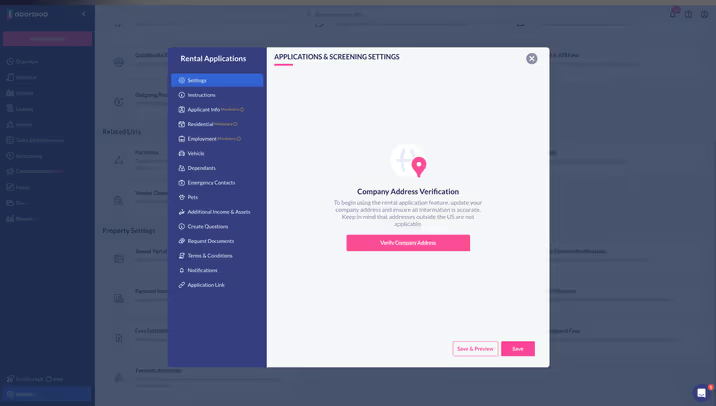Tenant screening and rental applications are two powerful features within DoorLoop that can save you time, reduce risk, and help you secure the best tenants for your properties.
By streamlining these critical processes, DoorLoop equips you with the tools you need to protect your investments and make confident, informed decisions. A single bad tenant can lead to thousands in lost rent, property damage, legal fees, and a lost security deposit.
Now is the time to unlock these features and elevate your property management to the next level. This guide breaks down the essential 5 steps for screening tenants, helping you minimize risk and find reliable renters for your rental properties.
Why Tenant Screening and Rental Applications Matter
Finding the right tenants can make or break your rental business. The process of screening applicants ensures you’re choosing responsible individuals who will pay rent on time, take care of your property, and follow lease agreements.
For property owners and real estate agents, a standardized process is crucial for three key reasons:
- Reduce Risk: Avoid costly evictions and property damage by vetting applicants thoroughly.
- Save Time: Streamline decision-making with structured applications and automated screenings.
- Ensure Compliance: Follow Fair Housing laws with a transparent and standardized process.
How to Screen Tenants: A Step-by-Step Guide
1. Establish Your Tenant Screening Criteria
Before screening applicants, define your rental criteria to ensure consistency and reduce risk. Common checks include:
- Income: Set a minimum income-to-rent ratio.
- References: Verify landlord and employment history.
- Credit history: Prioritize applicants with scores above your threshold, such as 650.
- Evictions and criminal history: Screen for past issues.
Tailor these criteria to fit your property and concerns. For example, prioritize high-income tenants or those with strong references. Clear thresholds simplify the tenant screening process.
Screening criteria vary by asset class—e.g., guarantors in student housing or park-rule compliance in mobile home communities—so align your thresholds with your portfolio.
2. Conduct Pre-Screening with Rental Ads
Make your rental criteria clear in your ads to help pre-screen applicants. By stating requirements upfront, prospective renters can self-screen, saving you time and reducing unqualified applications.
Ensure your application collects all necessary details for thorough screening. Using professional, standardized rental form templates ensures you collect the same information from every prospect:
- Basic contact information
- Social Security number (SSN)
- Address history
- Driver’s license number
- Current employer and income
- Rental history and reason for leaving
- Pet and smoking details
- Criminal background
- References
Publish vacancies everywhere in a few clicks with rental ads that syndicate to Zillow, Trulia, and more. Clear and detailed ads and applications streamline the pre-screening process and attract qualified applicants.
For commercial portfolios, pre-screen for suite fit (e.g., build-out needs, CAM track record) and centralize responses in DoorLoop.
3. Run Credit and Background Checks
Once applications are submitted, it's time to run comprehensive tenant background checks. While you can try to piece together information manually, professional tenant screening services from trusted providers are far more efficient and reliable. These reports, which often include eviction reports and searches of court records, are governed by the Fair Credit Reporting Act (FCRA).
DoorLoop integrates SmartMove to streamline this process. SmartMove predicts evictions up to 15% more effectively than standard credit reports. A thorough check should also scan for a name match on the national sex offender registry and government watchlists like the OFAC list, giving you the data you need to make better decisions, faster.
f the information on these reports leads you to deny an applicant, you are legally required to provide them with a Rental Application Denial (Adverse Action) Letter.
4. Verify Income and Landlord References
After reviewing the screening reports, the next steps are employment verification and collecting landlord references. This step can uncover critical information that reports may miss, such as recent job loss or poor rental history.
Verifying references ensures you have a complete picture of the applicant, helping you make more informed decisions and avoid potential issues.
💡Tip: For large multifamily or scattered residential portfolios, reuse application templates across buildings to keep standards consistent
5.Interview Applicants and Make a Decision
As a final step, connect with applicants directly—either in person, a call, another communication tool. This helps confirm their identity and allows you to ask clarifying questions about their application. Some landlords also check public social media profiles, but be cautious to only use information that does not conflict with Fair Housing laws.
This conversation can also clarify any questionable details in their application. For instance, a poor mark might have a reasonable explanation. Use this opportunity to ensure the tenant aligns with your expectations before making a decision.
6. After Move-In: Documenting Everything
A successful tenancy relies on clear records from day one. Always document every payment to maintain a clear financial record; a simple Rent Receipt Template is perfect for this. For a complete overview, track all payments and balances for each tenant in a Rent Ledger Template.
💡 Find state-specific applications and notices for Florida, Texas, or California.
How To Simplify and Speed Up Your Screening Process
Rental applications are your first opportunity to collect the information you need to evaluate potential tenants. With DoorLoop, you can customize your applications to fit your specific requirements, making the process efficient and thorough.
Get Started Fast with Customizable Online Applications
Easily share your listings with prospects using the "sharable link" from your dashboard. This link directs applicants to a dedicated site displaying all your available properties. From there, applicants can simply select the rental they’re interested in and start their application instantly.
Prospective tenants can submit applications, pay fees, and initiate TransUnion SmartMove background checks online, streamlining the process without manual intervention.
Setting up rental applications in DoorLoop starts with your company-level settings, which act as the default for all your properties. Check out this article on configuring your company rental application settings.
DoorLoop lets you tailor rental applications at both the company and property levels. You can adjust application fees, include specific questions, and set requirements. DoorLoop recommends the All-in-One Solution.

You can easily mark units as open for applications and share application links via email, text, or your website, simplifying the process for both you and prospective tenants.

Preview and test your rental applications directly from your dashboard. With just a click, you can see the application exactly as your prospects will, allowing you to make edits and customize it to fit your needs before it goes live.

Need subsidy and compliance documentation workflows? See how affordable housing portfolios handle payments, files, and reporting.
Get Comprehensive Reports in Minutes
Once an application is submitted, you need answers fast. DoorLoop’s integrated screening, powered by TransUnion, delivers comprehensive reports directly to your dashboard in minutes.
With a few clicks, you get a complete screening package with an all-in-one report that includes:
- A comprehensive credit check
- Eviction records
- Criminal background check
There’s no need to chase down applicants or use separate, clunky tools. Everything you need to make an informed decision is in one place.
TransUnion sets the reports to expire after 60 days, so be sure to review and save them before they disappear. You can also download the reports and upload them to the lease in DoorLoop to keep them indefinitely.
Ensure Consistency and Compliance Automatically
Staying compliant with Fair Housing laws is non-negotiable, and consistency is key. Using the same standardized online application and screening criteria for every applicant is one of the best ways to protect yourself.
DoorLoop helps you maintain a fair and consistent process automatically. By systemizing your workflow, you reduce the risk of unintentional bias and ensure every applicant is evaluated against the same standards—the smart way to minimize risk.
Unlock DoorLoop's Full Potential
DoorLoop’s rental applications and online tenant screening tools are designed to save you time, reduce risk, and help you find the best tenants for your properties.
By automating and simplifying these essential processes, you’ll streamline your workflow and make smarter decisions for your rentals. These powerful tools are just a few clicks away!
How to screen tenants FAQ
What is the first thing to check when screening a tenant?
The very first thing you should verify is the applicant's income with an income verification calculator. If a tenant can't comfortably afford the rent, the other checks are irrelevant. Most landlords and property managers look for a gross monthly income that is at least three times the monthly rent, as this is a strong indicator that they can handle their financial obligations.
What are major red flags to look for when screening tenants?
While every situation is unique, several red flags should prompt a closer look. Be cautious if you see:
- A prior eviction history. This is one of the strongest predictors of future issues.
- A history of late payments, significant bankruptcies, or a low credit score.
- Inconsistent or unverifiable employment and income.
- Negative references from previous landlords.
- Providing false or incomplete information on their application.
How long does the tenant screening process take?
The timeline depends on your method. A manual process involving phone calls and waiting for responses can take several days. However, with modern property management software like DoorLoop, the process is built for speed.
Once an applicant submits their information online, you can often get comprehensive screening reports back in just a few minutes. This efficiency has a major impact on pricing, as the time you save is money earned.
What does a tenant screening report include?
A comprehensive tenant credit check and screening report typically bundles three critical checks from bureaus like Equifax or TransUnion into a single document:
- A full credit report, including their credit score and payment history.
- A national background check that searches criminal records for relevant convictions.
- A detailed eviction history showing any past eviction filings.
































.svg)
.svg)

